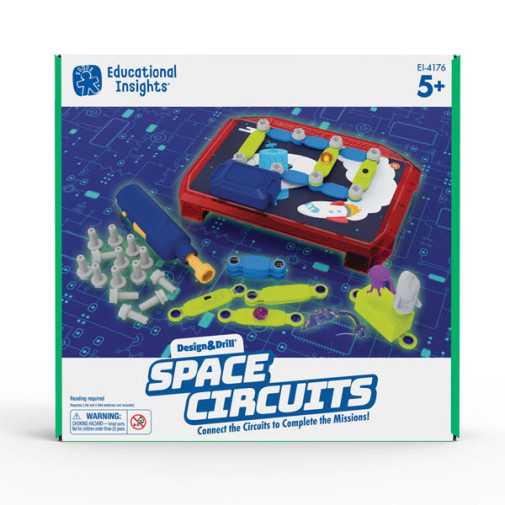We use cookies to make your experience better. To comply with the new e-Privacy directive, we need to ask for your consent to set the cookies. Learn more.
Design & Drill Space Circuits
SKU
013552
Grade K-3
These icons are designed to help you quickly understand and learn important information about our products.
Teaching Method
Traditional
Teacher-centered curriculum commonly used in classrooms that may include a text, teacher manual, tests, etc.
Charlotte Mason
A methodology based on the work of a 19th century educator who maintained that children learn best from literature (Living Books), not textbooks.
Classical
A methodology based on the Latin Trivium (three stages of learning), including the grammar stage (memorization and facts), logic stage (critical thinking), and rhetoric stage (developing/defending ideas).
Unit Study
A thematic or topical approach centered around one topic that integrates multiple subject areas.
Montessori (Discovery)
A methodology based on the work of a 20th century educator that emphasizes student and sensory-driven discovery learning and real-life applications.
Other
Other methodologies
Religious Content
Secular
Contains content contrary to common Christian beliefs (i.e. evolution).
Neutral
Avoids religious or theoretical topics or presents multiple viewpoints without preference.
Christian/Religious
Faith-based or including instructional religious content.
Learning Modality
Auditory
Learns through listening, talking out loud or reading out loud.
Visual
Learns through seeing, prefers written instructions and visual materials.
Kinesthetic/Tactile (Hands-On)
Learns through moving, doing and touching.
Multi-Sensory
Curriculum that employ a variety of activities/components.
Presentation
Sequential
Curriculum progresses through well-defined learning objectives. Emphasizes mastery before moving to the next topic.
Spiral
Topics and concepts are repeated from level to level, adding more depth at each pass and connecting with review.
Conceptual/Topical
Focus is on the “why,” often with a unifying concept as well as specific skills; coverage may be broader.
Teacher Involvement
Low Teacher Involvement
Student-led materials; parent acts as a facilitator.
Medium Teacher Involvement
A mix of teacher-led time and independent student work.
High Teacher Involvement
Teacher-led lessons; may utilize discussions, hands-on activities and working together.
Additional Materials Required
No other materials needed
Everything you need is included.
Other Materials Required
There are additional required resources that are a separate purchase.
Other Materials Optional
There are additional resources mentioned or recommended but are not absolutely necessary.
Consumable
Consumable
Designed to be written in; not reusable.
Non-Consumable
Not designed to be written in; reusable.
Our Price
$56.99 $56.99 $38.84
Rainbow Savings: $18.15
Warning
Choking Hazard
- Small parts. Not for children under 3 years.
Description
Design & Drill meets electronic circuitry! Place one of the colorful, double-sided mission cards on the space circuit board to get started. The instruction booklet is full of information about the goal of each mission, and how to safely (and how not to!) construct circuits. See if you can complete all of the missions to get your crew from liftoff to returning home. Set includes board, bolts, connectors, moon dome, battery pack, electric screwdriver, mission cards, and instruction guide. Requires 3 AA and 3 AAA batteries, not included.
Publisher's Description of Design & Drill Space Circuits
Mini STEM-gineers use a kid-safe power drill to complete 20 space-themed challenges to create circuits that really work!
- Includes space circuit board, kid-safe power drill, 20 bolts, 1 battery pack, 12 short connectors, 5 long connectors 10 double-sided challenge cards, and guide
- Learn to light, spin simple motors, add momentary buttons and switches, and more
- Requires 3 AAA and 2 AA batteries (not included)
- Supports STEM: Introduce tools, encourage problem-solving, inspire creativity
Details
| Product Format: | Other |
|---|---|
| Brand: | Educational Insights |
| Grades: | K-3 |
| EAN/UPC: | 086002041760 |
| Length in Inches: | 11.625 |
| Width in Inches: | 12.25 |
| Height in Inches: | 3.25 |
| Weight in Pounds: | 2.15 |
Videos
Reviews

